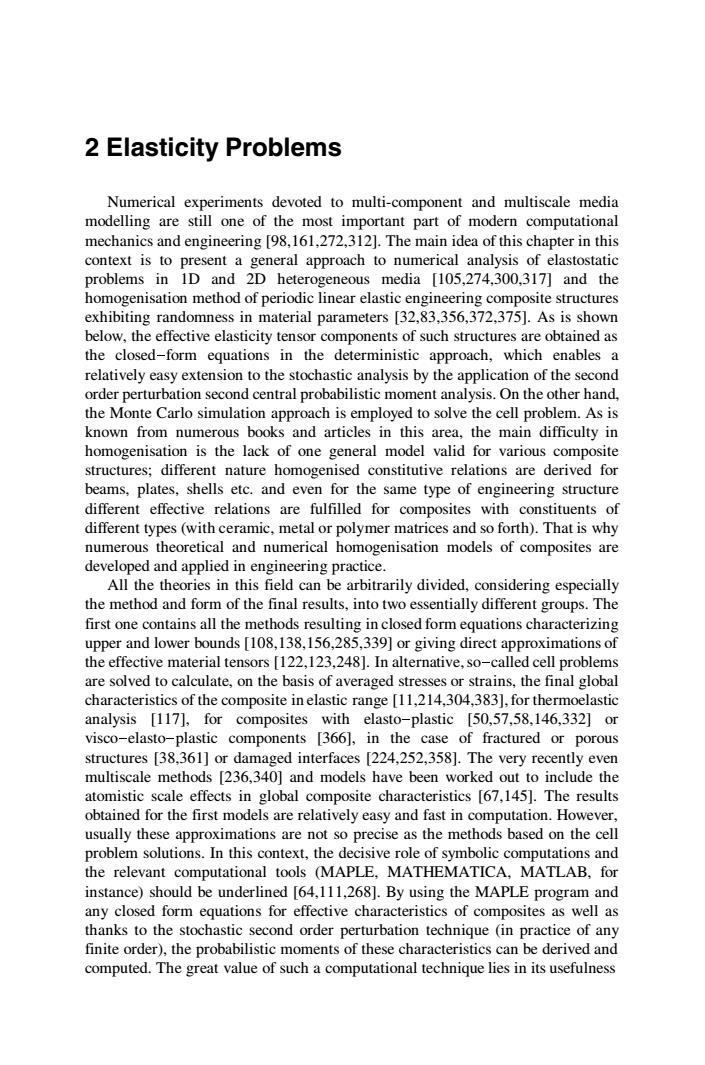正在加载图片...

2 Elasticity Problems Numerical experiments devoted to multi-component and multiscale media modelling are still one of the most important part of modern computational mechanics and engineering [98,161,272,312].The main idea of this chapter in this context is to present a general approach to numerical analysis of elastostatic problems in 1D and 2D heterogeneous media [105,274,300,317]and the homogenisation method of periodic linear elastic engineering composite structures exhibiting randomness in material parameters [32,83,356,372,375].As is shown below,the effective elasticity tensor components of such structures are obtained as the closed-form equations in the deterministic approach,which enables a relatively easy extension to the stochastic analysis by the application of the second order perturbation second central probabilistic moment analysis.On the other hand, the Monte Carlo simulation approach is employed to solve the cell problem.As is known from numerous books and articles in this area,the main difficulty in homogenisation is the lack of one general model valid for various composite structures;different nature homogenised constitutive relations are derived for beams,plates,shells etc.and even for the same type of engineering structure different effective relations are fulfilled for composites with constituents of different types(with ceramic,metal or polymer matrices and so forth).That is why numerous theoretical and numerical homogenisation models of composites are developed and applied in engineering practice. All the theories in this field can be arbitrarily divided,considering especially the method and form of the final results,into two essentially different groups.The first one contains all the methods resulting in closed form equations characterizing upper and lower bounds [108,138,156,285,339]or giving direct approximations of the effective material tensors [122,123,248].In alternative,so-called cell problems are solved to calculate,on the basis of averaged stresses or strains,the final global characteristics of the composite in elastic range [11,214,304,383],for thermoelastic analysis [117],for composites with elasto-plastic [50,57,58,146,332]or visco-elasto-plastic components [366],in the case of fractured or porous structures [38,361]or damaged interfaces [224,252,358].The very recently even multiscale methods [236,340]and models have been worked out to include the atomistic scale effects in global composite characteristics [67,145].The results obtained for the first models are relatively easy and fast in computation.However, usually these approximations are not so precise as the methods based on the cell problem solutions.In this context,the decisive role of symbolic computations and the relevant computational tools (MAPLE,MATHEMATICA,MATLAB,for instance)should be underlined [64,111,268].By using the MAPLE program and any closed form equations for effective characteristics of composites as well as thanks to the stochastic second order perturbation technique (in practice of any finite order),the probabilistic moments of these characteristics can be derived and computed.The great value of such a computational technique lies in its usefulness2 Elasticity Problems Numerical experiments devoted to multi-component and multiscale media modelling are still one of the most important part of modern computational mechanics and engineering [98,161,272,312]. The main idea of this chapter in this context is to present a general approach to numerical analysis of elastostatic problems in 1D and 2D heterogeneous media [105,274,300,317] and the homogenisation method of periodic linear elastic engineering composite structures exhibiting randomness in material parameters [32,83,356,372,375]. As is shown below, the effective elasticity tensor components of such structures are obtained as the closed-form equations in the deterministic approach, which enables a relatively easy extension to the stochastic analysis by the application of the second order perturbation second central probabilistic moment analysis. On the other hand, the Monte Carlo simulation approach is employed to solve the cell problem. As is known from numerous books and articles in this area, the main difficulty in homogenisation is the lack of one general model valid for various composite structures; different nature homogenised constitutive relations are derived for beams, plates, shells etc. and even for the same type of engineering structure different effective relations are fulfilled for composites with constituents of different types (with ceramic, metal or polymer matrices and so forth). That is why numerous theoretical and numerical homogenisation models of composites are developed and applied in engineering practice. All the theories in this field can be arbitrarily divided, considering especially the method and form of the final results, into two essentially different groups. The first one contains all the methods resulting in closed form equations characterizing upper and lower bounds [108,138,156,285,339] or giving direct approximations of the effective material tensors [122,123,248]. In alternative, so-called cell problems are solved to calculate, on the basis of averaged stresses or strains, the final global characteristics of the composite in elastic range [11,214,304,383], for thermoelastic analysis [117], for composites with elasto-plastic [50,57,58,146,332] or visco-elasto-plastic components [366], in the case of fractured or porous structures [38,361] or damaged interfaces [224,252,358]. The very recently even multiscale methods [236,340] and models have been worked out to include the atomistic scale effects in global composite characteristics [67,145]. The results obtained for the first models are relatively easy and fast in computation. However, usually these approximations are not so precise as the methods based on the cell problem solutions. In this context, the decisive role of symbolic computations and the relevant computational tools (MAPLE, MATHEMATICA, MATLAB, for instance) should be underlined [64,111,268]. By using the MAPLE program and any closed form equations for effective characteristics of composites as well as thanks to the stochastic second order perturbation technique (in practice of any finite order), the probabilistic moments of these characteristics can be derived and computed. The great value of such a computational technique lies in its usefulness